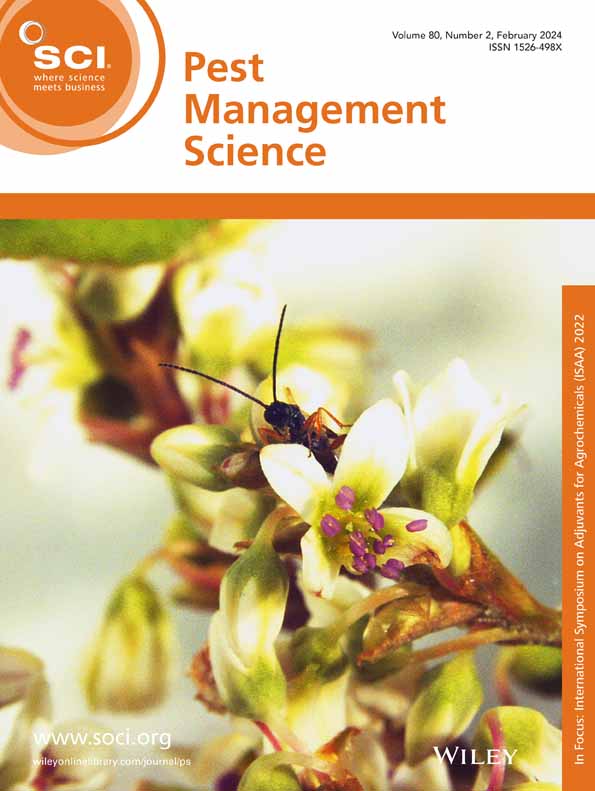异硫氰酸烯丙酯对飞蛾卵团的杀伤作用。
IF 3.8
1区 农林科学
Q1 AGRONOMY
引用次数: 0
摘要
飞行海绵蛾复合体(FSMC)不仅在寄主植物上产卵,而且在各种人工结构上产卵,如货物、车辆和船舶。因此,防止这些卵团的传播是一项国际挑战。它们的卵上覆盖着厚厚的毛发,作为杀虫剂的屏障,从而使它们无效。一种挥发性气体可能会携带有毒物质通过这个屏障到达卵子。本研究评价了高挥发性异硫氰酸烯丙酯(AITC)对异天蛾虫卵的杀虫效果,并与氯菊酯、甲氰菊酯和噻虫胺两种常规杀虫剂的杀虫效果进行了比较。结果在两种常规杀虫剂处理下,未去除毛状覆盖物的虫卵成活率约为50%。相比之下,AITC处理后,所有卵,无论有无毛状覆盖物,均未孵化。AITC对它们的LC50和LC90分别为37.3±5.4 ppm和100.9±11.8 ppm。我们的研究结果表明,AITC在35000 ppm时可以根除FSMC卵团。结论aitc对FSMC卵团有一定的杀伤作用,可用于除FSMC外的其他生物的卵/卵团的清除。©2025作者。由John Wiley & Sons Ltd代表化学工业协会出版的《害虫管理科学》。本文章由计算机程序翻译,如有差异,请以英文原文为准。
Lethal effects of allyl isothiocyanate on the egg masses of flighted spongy moth complex Lymantria dispar japonica (Lepidoptera: Erebidae).
BACKGROUND
The flighted spongy moth complex (FSMC) lays egg masses not only on host plants but also various artificial structures, such as, cargo, vehicles, and ships. Thus, preventing the transmission of these egg masses is an international challenge. Their eggs are covered with thick hair covering that act as a barrier to insecticides thus making them ineffective. A volatile gas may be able to carry toxic substances past this barrier to the eggs. In this study, we evaluated the insecticidal effect of the highly volatile allyl isothiocyanate (AITC) on Lymantria dispar egg masses and compared it with that of two conventional insecticides containing permethrin, fenpropathrin, and clothianidin.
RESULTS
In the two conventional insecticide treatments, approximately 50% of the eggs survived when the hairy covering was not removed. In contrast, all eggs, with or without hairy covering, did not hatch after AITC treatment. The LC50 and LC90 values of AITC against them were 37.3 ± 5.4 and 100.9 ± 11.8 ppm, respectively. Our results show that AITC at 35000 ppm can eradicate FSMC egg masses.
CONCLUSION
AITC has a lethal effect against FSMC egg masses and may be applied for the extirpation of eggs/egg masses of various other organisms, besides FSMC. © 2025 The Author(s). Pest Management Science published by John Wiley & Sons Ltd on behalf of Society of Chemical Industry.
求助全文
通过发布文献求助,成功后即可免费获取论文全文。
去求助
来源期刊

Pest Management Science
农林科学-昆虫学
CiteScore
7.90
自引率
9.80%
发文量
553
审稿时长
4.8 months
期刊介绍:
Pest Management Science is the international journal of research and development in crop protection and pest control. Since its launch in 1970, the journal has become the premier forum for papers on the discovery, application, and impact on the environment of products and strategies designed for pest management.
Published for SCI by John Wiley & Sons Ltd.
 求助内容:
求助内容: 应助结果提醒方式:
应助结果提醒方式:


